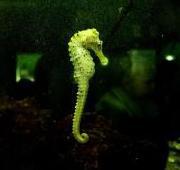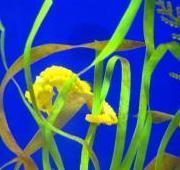 The seahorse is a small species of vertebrate that is found in the tropical shallows and temperate waters around the world. The sea horse is also commonly found around coral reefs where there is plenty of food and places for the seahorse to hide.
The seahorse is a small species of vertebrate that is found in the tropical shallows and temperate waters around the world. The sea horse is also commonly found around coral reefs where there is plenty of food and places for the seahorse to hide. The seahorse is most closely related to a pipe fish although, the seahorse does not have scales like most fish and instead the seahorse has a bone structure that is made up of little plates and covered with a thin layer of skin.
The seahorse is most closely related to a pipe fish although, the seahorse does not have scales like most fish and instead the seahorse has a bone structure that is made up of little plates and covered with a thin layer of skin.


The seahorse has a number of distinctive features which help the seahorse to survive in it's marine environment. The seahorse has a long snout for sucking in food and a long tail which the seahorse uses both for moving through the water and also for clinging onto coral and aquatic plants, which the seahorse does by curling this long tail around things in order to anchor itself down.
The seahorse is an omnivorous animal and the seahorse therefore eats a mixture of plant and animal matter which the seahorse does by sucking the food into it's body through it's elongated snout. The seahorse primarily feeds on brine shrimp. plankton, tiny species of fish and algae.
Due to the small size and vulnerability of the seahorse, the seahorse has numerous predators within it's natural environment. Crustaceans such as crabs, fish and rays are all common predators of the seahorse along with humans who harvest the seahorse for use in medicine. The seahorse is also vulnerable to bad weather as in storms, seahorses are often thrown from the place that they were clinging onto and onto the shore.
The sea horse is best known for the remarkable fact that the male seahorse is the one that actually carries the eggs before they hatch. In most other animal species the female of the species if the one to protect the offspring until birth. Instead the female seahorse lays her eggs (anywhere between 8 and 600 eggs are laid depending on the species of seahorse), into the male's brooding pouch where they remain until they hatch within around 3 weeks.
The seahorse is a highly endangered animal mainly due to habitat loss and over-hunting. The seahorse is a popular ingredient in medicine (mainly in the far east), and hundreds to thousands of seahorse are harvested every year for this purpose.

